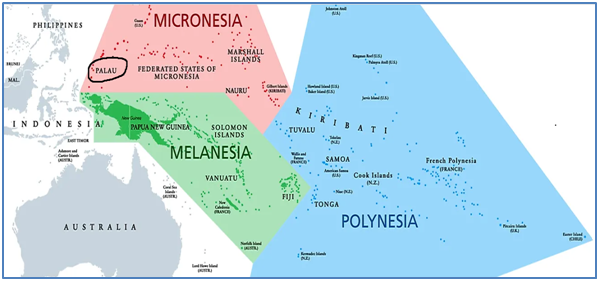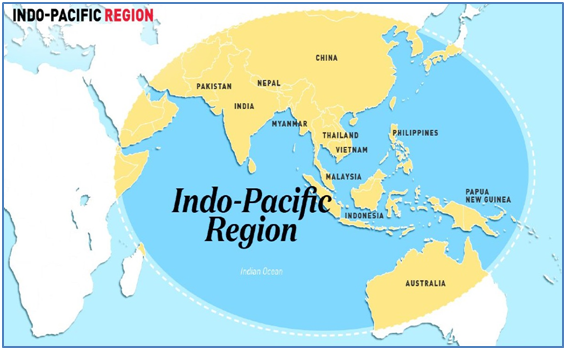Why in News?
- The United States has signed a new agreement with Palau, which gives American ships the authorisation to unilaterally enforce maritime regulations in the tiny Pacific Island nation’s exclusive economic zone.
- The agreement comes as both the U.S. and China are seeking to expand their influence in the Pacific, and follows pleas from Palau’s president for Washington’s help to deter Beijing’s “unwanted activities” in its coastal waters.
What’s in Today’s Article?
- Where is Palau Located?
- Role Played by the US in the Maritime Security of the Pacific Region
- Challenges faced by the US’ Maritime Security Goals in the Pacific Region
- About the Maritime Security Agreement signed by US with Palau
- Significance of the Agreement between US and Palau
Where is Palau Located?

- Palau (officially the Republic of Palau with capital Ngerulmud) is an island country in the Micronesia sub-region of Oceania in the western Pacific.
- The republic consists of approximately 340 islands and has a total area of 466 sq kms, making it one of the smallest countries in the world.
- Having voted in a referendum against joining the Federated States of Micronesia in 1978, the islands gained full sovereignty in 1994 under a Compact of Free Association with the United States.
- Politically, Palau is a presidential republic in free association with the United States, which provides defense, funding, and access to social services.
Role Played by the US in the Maritime Security of the Pacific Region:

- The US is an Indo-Pacific power. The region stretches from the USA's Pacific coastline to the Indian Ocean.
- The region is home to more than half of the world’s people, nearly two-thirds of the world’s economy, and 7 of the world’s largest militaries.
- The 2nd World War reminded the US that its country could only be secure if Asia was secure as well.
- So, in the post-war era, the US solidified its ties with the region, through ironclad treaty alliances with Australia, Japan, the Republic of Korea (ROK), the Philippines, and Thailand.
- This laid the foundation of security that allowed regional democracies to flourish through close trade and investment relationships with the US.
- The passage of time has underscored the strategic necessity of the US’ consistent role.
- At the end of the Cold War, the US considered but rejected the idea of withdrawing its military presence, understanding that the region held strategic value that would only grow in the 21st century.
- Since then, administrations in the US have shared a commitment to the region.
Challenges faced by the US’ Maritime Security Goals in the Pacific Region:
- In a quickly changing strategic landscape, American interests can only be advanced by anchoring itself in the region and strengthening the region itself, alongside its closest allies and partners.
- This intensifying American focus is due in part to the fact that the Indo-Pacific faces mounting challenges, particularly from China (PRC).
- The PRC is combining its economic, diplomatic, military, and technological might as it pursues a sphere of influence in the Indo-Pacific and seeks to become the world’s most influential power.
- The PRC’s coercion and aggression spans the globe, but it is most acute in the Indo-Pacific.
- From the conflict along the Line of Actual Control with India to the growing pressure on Taiwan and bullying of neighbors in the East and South China Seas, US’ allies bear much of the cost of the PRC’s harmful behavior.
- In the process, the PRC is also undermining human rights and international law, including freedom of navigation, as well as other principles that have brought stability and prosperity to the Indo-Pacific
About the Maritime Security Agreement signed by US with Palau:
- In the agreement, the US Coast Guard ships can enforce regulations inside Palau’s exclusive economic zone on behalf of the nation without a Palauan officer present.
- This agreement helps Palau monitorits exclusive economic zone, protect against illegal, unreported, and unregulated fishing, and deter uninvited vessels from conducting questionable maneuvers within its water.
- The partnership will help toward achieving the common goal of peace and prosperity in the region.
Significance of the Agreement between US and Palau:
- Palau is one of the few countries that recognises Taiwan and maintains diplomatic relations with the island.
- Elsewhere in the Pacific, the government of the Solomon Islands was persuaded to switch its diplomatic recognition of Taiwan to China in 2019.
- Since then, the Solomons signed a secretive security pact with China that has given rise to concerns it could give Beijing a military foothold in the South Pacific.
- The US has countered with diplomatic moves of its own, including opening an embassy in the Solomon Islands.
- The agreement with Palau is similar to one concluded with the Federated States of Micronesia at the end of 2022. The US also signed a bilateral defense agreement with Papua New Guinea.
- The agreements show the US’ ongoing investment in protecting shared resources and an interest in maritime safety and security.
- This unity of effort with Pacific Island countries, including Palau, amplifies the US' collective ability to protect resources and maintain a free and open Indo-Pacific for all nations who observe the rule of law.









